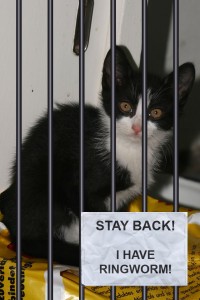Run Rings Around Ringworm

 Despite its name, ringworm is NOT caused by a worm but by a fungus.
Despite its name, ringworm is NOT caused by a worm but by a fungus.
Known as dermatophytes, these fungi can infect the skin, hair and nails of any cat anywhere and is highly contagious, easily spreading to other household pets as well as to people.
Classic symptoms of ringworm or dermatophytosis include skin lesions on the head, ears and forelimbs. It can cause flaky, bald patches that sometimes appear red in the center. Milder cases may present either as localized areas of redness or simply as dandruff, while in more severe cases, the infection can spread over a cat’s whole body. Some cats can even carry ringworm spores and show no symptoms at all. But these spores are notoriously hardy and can survive for more than a year.
While any cat can develop ringworm, young kittens under the age of one and senior cats, longhaired cats and immunocompromised cats are most susceptible. Ringworm is transmitted through DIRECT contact with an infected animal or INDIRECTLY through contact with anything – from food and water bowls to blankets and cat beds, cat trees and cat toys — that has been contaminated with the skin cells or hairs of an infected pet.
If you suspect your cat may have ringworm (and because it’s so contagious), you should quarantine that cat from any other pets in your household until you see a vet, and wash your hands thoroughly after touching your cat. To ensure an accurate diagnosis, vets may use an ultraviolet light and/or examine a fungal culture taken from your cat’s hair and/or skin cells. Skin biopsies and microscopic exams are sometimes performed as well.
Treating ringworm depends on the severity of the infection. Your vet may prescribe a shampoo or ointment containing a special medication to kill the fungus. In some cases, oral medications will be necessary. To make certain you’ve eradicated this stubbornly resistant fungus, your cat’s treatment may continue for several months or longer with fungal cultures rechecked periodically. It’s also important to sanitize your cat’s environment to contain and ultimately prevent a recurrence of the infection.
This includes:
- Bathing your other pets with a medicated rinse or shampoo.
- Washing the infected cat’s bedding and toys with a disinfectant that kills ringworm spores.
- Discarding items that are impossible to thoroughly disinfect (e.g. carpeted cat trees). Vacuuming daily to rid your home of infected hairs and skin cells, since the fungus can survive on the hair and skin your cat sheds, while the spores themselves can live in your carpeting for up to 18 months.
- Wearing latex or rubber gloves and continuing to wash your hands thoroughly each time you touch or bathe your cat.
Ringworm treatment is usually continued until your cat has had two negative cultures one week apart.
